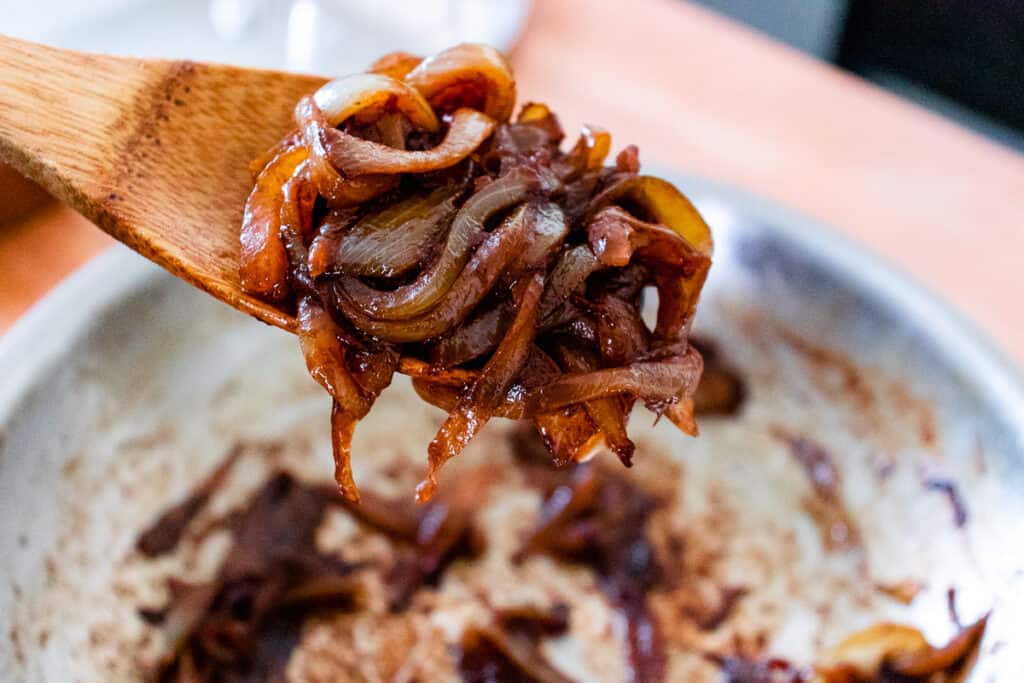
If you’ve ever needed to caramelize onions in a hurry and you don’t need to make a lot, we’ve found a method that gets results in a fraction of the time it normally would take you cooking low and slow.
So how do you caramelize onions fast? You can caramelize 1 to 2 onions quickly in about 10 minutes by cooking them in a high-heat pan, such as stainless steel, while continually deglazing the pan to prevent them from burning. Cooking on a higher heat allows you to rapidly sweat the onions and accelerates the caramelization process, which is what turns the onions sweet and brown.
Below is a quick start guide that goes over the steps. After that, we go over exactly what we discovered to make caramelized onions in a jiffy.
CARAMELIZED ONIONS QUICK GUIDE
Note: This method works best for 1-2 onions at a time.
- Set a high heat skillet, such as stainless steel or cast iron, on high heat for 2-3 minutes.
- Add 1 tbsp each of vegetable oil and butter to the pan, allowing the butter to melt.
- Add ¼ inch julienne sliced onion strips to the pan.
- Use a wood spoon or spatula to spread the onions out in a thin layer.
- Sprinkle with a pinch of salt.
- Cover and allow the onions to sweat and soften, about 1-2 minutes.
- Uncover and push onions to edges of pan to reveal the brown fond.
- Deglaze the pan with just enough liquid to release the fond with a wooden spoon.
- Stir onions around pan to coat with brown fond and spread back into a thin layer.
- Allow the fond to reform, no longer than 2 minutes.
- Repeat deglazing / fond formation process until onions are as caramelized as you prefer.
What makes onions caramelize faster?
The key to making caramelization happen as fast as possible is by not overcrowding the pan. You do this by cooking fewer onions. That’s 1 large onion in a 10-inch pan, and no more than 2 in a 12-inch pan. This allows you to distribute the onions evenly. When all the pieces are making contact with the heat, caramelization occurs at the same rate.
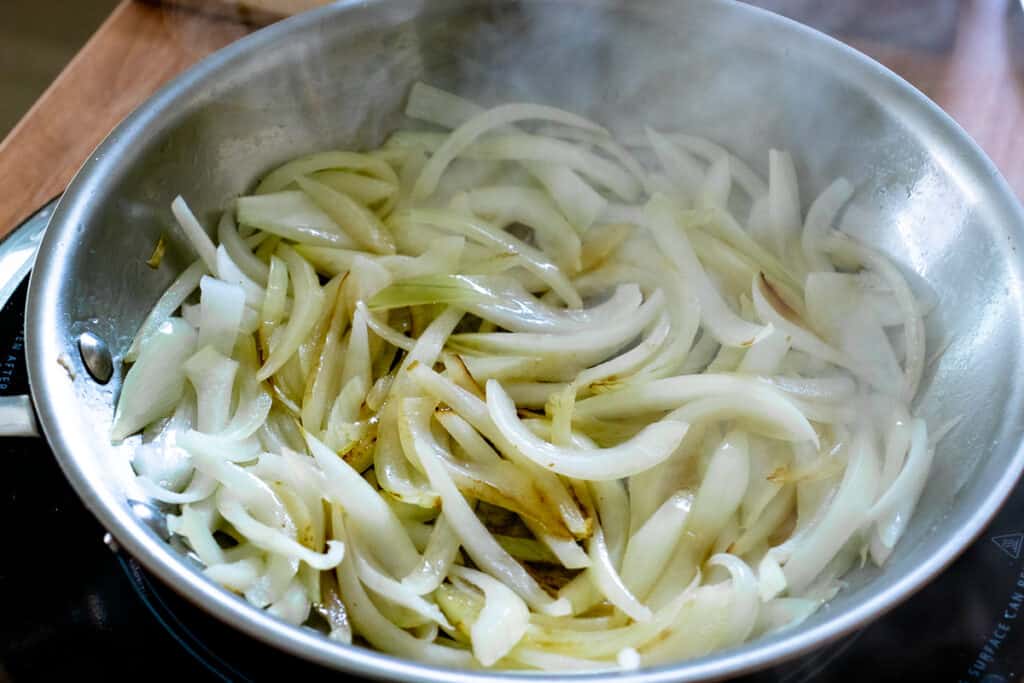
Why this method works and won’t burn up the onions
Caramelization occurs when the water and sugar in the onions are released. The water then evaporates, and the sugar browns.
This creates new flavor compounds and browned bits (called the fond) that will stick to the bottom of the pan.
In standard methods for caramelizing onions, this process happens at a lower temperature for a longer period of time. This prevents the onions from drying out and the caramelized brown bits on the pan from burning.
However, it’s possible to maintain a high level of heat and accelerate caramelization without burning up the onions. This is achieved by replacing the moisture and deglazing the pan regularly.
When the pan is deglazed, all of the brown bits that have accumulated can be lifted off the pan and will get transferred back on the onions.
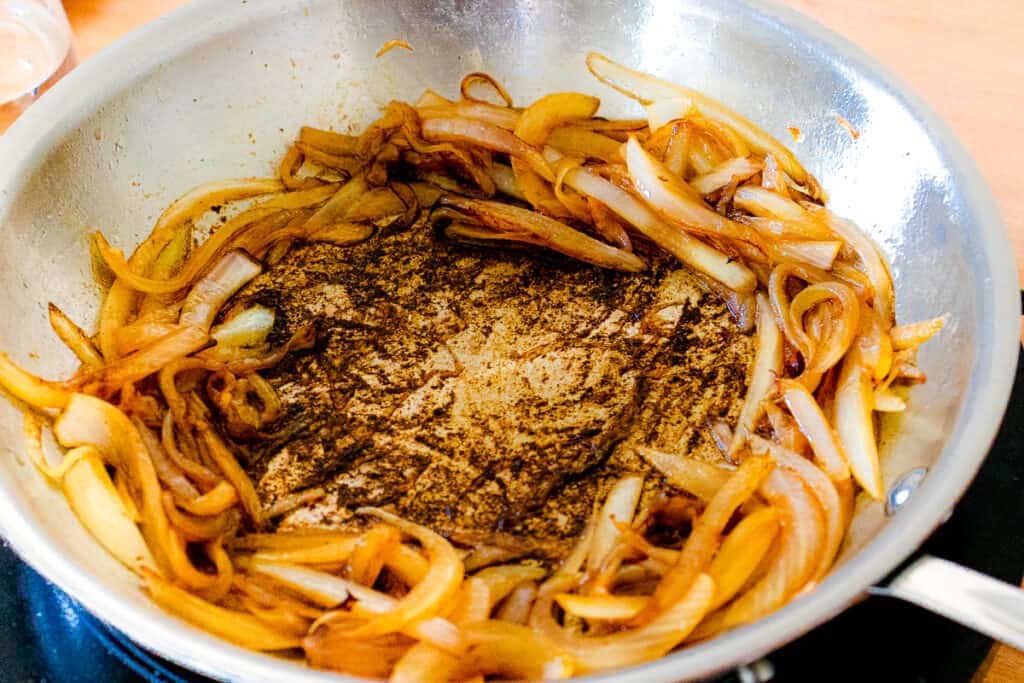
As you continue to cook the onions, the fond reforms on the pan. By continually deglazing and reforming the fond, the onions become caramelized.
Follow these tips for caramelizing onions faster
Slice the onions evenly

This one is important. If you slice the onions evenly they will cook at the same rate. Otherwise some pieces will finish cooking well before the others.
The easiest way to do this to cut an onion in half and make ¼ inch slices from pole to pole. If you’d like more information on this, check out our quick and easy guide to cutting onions.
What kind of onions are best to caramelize?
You can caramelize any onion, but yellow and red onions have more complex flavors. You can even mix and match onions for more variety, just make sure you slice them all evenly.
For this method we don’t recommend cooking more than 1 pound of onions at a time, which is about 2 onions.
Salt the onions
Adding salt makes the onions release water faster and sweat. You only need a pinch. You’re trying to release moisture not season. You don’t want overly salty onions or you won’t be able to taste the caramelize sugars that are released.
We like sea salt, but you can use iodized table salt if you’d like. Some people can taste a metallic aftertaste with iodized salt.
Use a high-heat pan
Having the right kind of pan is what makes this cooking method possible. This is NOT something you want to try in a non-stick pan.
Why not use non-stick?
- Non-stick isn’t designed to be heated high and you could ruin the finish of the pan, as well as possibly release toxic substances in the food.
- The dark coating doesn’t allow you to see the fond as easily or to know if it’s getting too dark.
- Also because you’ll be scraping the bottom with a spoon, you can scratch up your pan.
You want to use a high-heat pan such as stainless steel or enameled cast-iron. These are ideal because it will not only heat up fast, but will allow you to see the fond forming on the bottom.
It’s very easy to go from brown and caramelized to black and burnt, so being able to see the color helps a lot.
What size pan to use for caramelizing onions fast?
Use a pan large enough to spread the onions out in a thin layer so that all the slices are making contact with the pan.
Depending on how many onions you are caramelizing, a 10-inch pan will work for one onion, but a 12-inch would be better for 2 onions.
Note: You’ll need a cover to initially release the water and sugars. If your pan doesn’t come with a cover you can use a round pizza pan or baking sheet.
The main thing to remember is try not to crowd the pan so the onions will release water faster and caramelize evenly.

As demonstrated above, there’s a little too much onion in the 10-inch pan, and some pieces are caramelizing faster than others, so a larger pan would work better. However if all you have is a smaller pan, you can remove the extra onion, set it aside and caramelize it in a separate batch.
Should you use vegetable oil or butter to caramelize onions?
The short answer is both. Both not only keep the onions from sticking to the pan, they also help the flavor immensely. While you technically can cook onions without oil to make caramelization happen, the onions can release sulphuric-tasting flavors when sweating on their own.
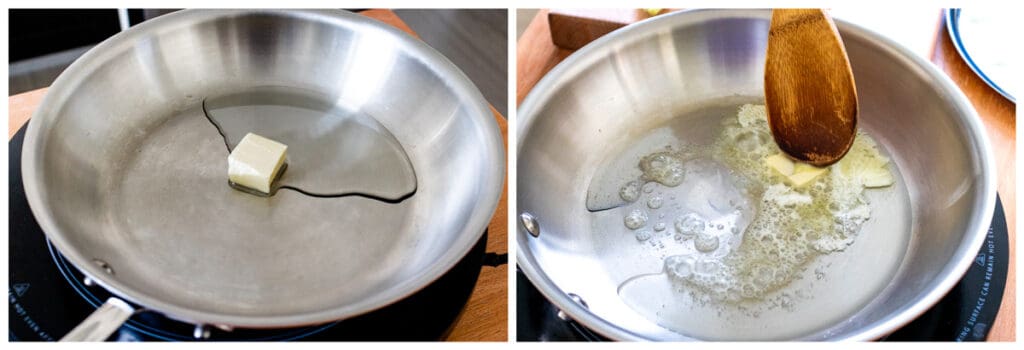
You may have encountered this if you’ve ever boiled onions. When the onions are coated with a fat, it prevents this unpleasant chemical reaction from occurring while enhancing the flavor and maintaining its texture.
We like using a 1:1 combination of vegetable oil and butter. The onions shouldn’t be swimming in oil because then you’ll be frying them and not caramelizing. You just need enough to coat the bottom of the pan.
Butter has milk solids which brown at higher heats, and this will help speed up the caramelization of the onions. However, butter on its own has a low smoke point and can burn quickly, so the vegetable oil can help prevent this.
We don’t recommend fats with low smoke points by themselves, like olive oil, for this method because you’ll wind up with a burnt mess.
Use a wooden spoon or spatula to scrape up fond
A wooden spoon is strong and sturdy, allowing you to get a good grip. It also has more surface area that makes it possible to push and release the fond that forms and sticks to the pan.
Unlike spoons and spatulas made of other materials, you won’t have to worry about it burning or melting in this high-heat environment.
What liquid should you use to deglaze the pan?
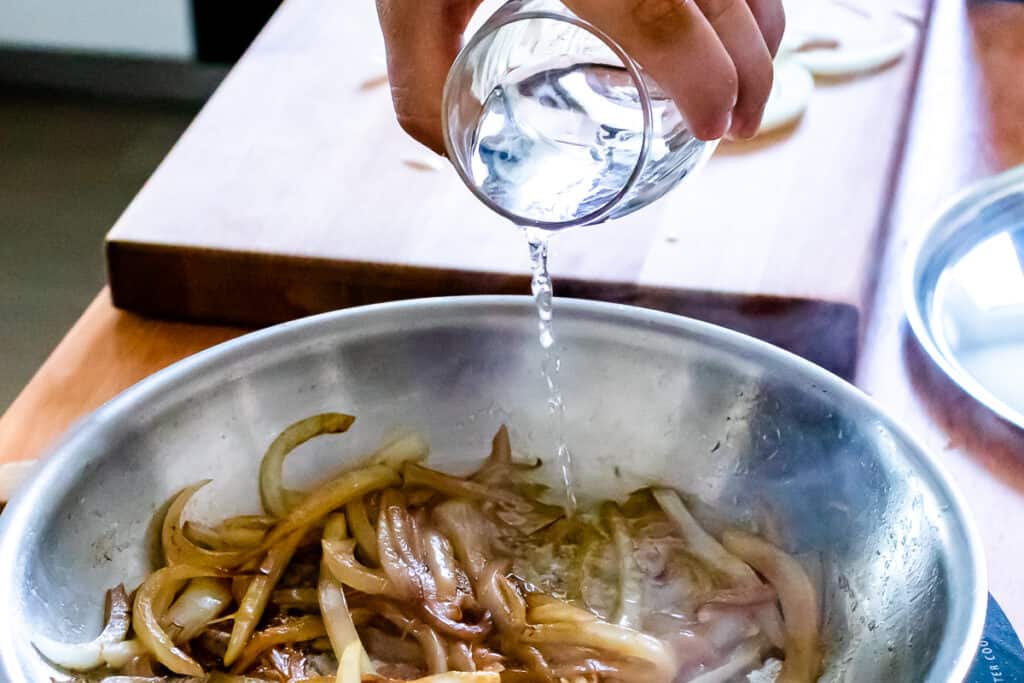
As mentioned before, deglazing the pan releases the fond that sticks to the pan while keeping the onions from drying out.
All you really need is water, but if you want to add other flavors into your onions, you can deglaze with wine, beer or liquor (only if you’re of legal drinking age of course).
If you are using alcohol to deglaze, make sure to remove the pan from the heat when you’re adding the liquid to avoid flames or steaming your face (especially when using a gas range).
When are caramelized onions done?

This is largely a personal preference. Caramelized onions typically go beyond golden brown in color to a deep chocolate brown.
The longer you cook them, the darker and sweeter they become. If you’re going for the darkest caramelization, you need to stop cooking them just short of burning. It’s necessary to taste a piece before it gets to this stage.
Additional tips to accelerate caramelization in onions
These are optional steps but are effective at speeding up the process.
Adding sugar to the onions
You can add sugar when adding salt. The extra sugar can start the caramelization faster because the crystals are exposed to heat. The onions contain enough natural sugar that you shouldn’t need to add any unless you prefer your onions to be extra sweet.
Adding baking soda to the onions
If you mix a small amount of baking soda with water and add it to the onions, it creates a high pH environment that speeds up browning and caramelization. However, this also breaks down the onions rapidly. If you decide to use baking soda, add it toward the end to avoid a pile of mush.

Leave a Reply